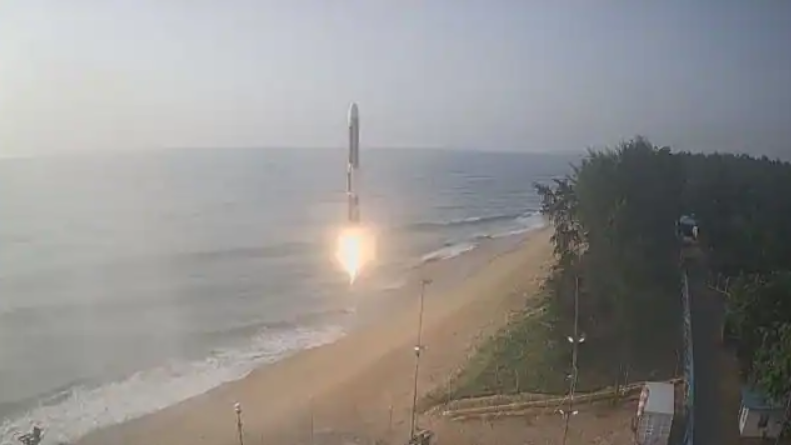Launching “Agnibaan – SOrTeD,” the first rocket propelled by a completely 3D-printed engine, on May 31, 2024, Agnikul Cosmos, an innovative Indian company housed at IIT Madras, made history in the space industry. This ground-breaking accomplishment not only marks a turning point for the company but also attests to the creative energy and technical expertise that IIT Madras cultivates. The launch, from Sriharikota’s first-ever privately constructed launchpad, “Dhanush,” is a significant milestone for India’s developing commercial space sector. Read more, IIT Madras BS Data Science Application Registration Opens; Exam on July 7

IIT Madras: A Hub of Innovation
IIT Madras, one of India’s most prestigious engineering institutions, has long been at the forefront of research, technological advancements, and innovation. Established in 1959, the institute has consistently been ranked among the top engineering schools in India and has gained international acclaim for its rigorous academic programs and cutting-edge research.
The university is a humming community of academics, researchers, and businesspeople who all support an innovative and high-achieving culture. Startups in several industries have benefited greatly from the institute’s incubation cell. Innovative ideas may grow at IIT Madras because of its access to cutting edge facilities, professional mentoring, and financing options. One excellent illustration of this supportive atmosphere is Agnikul Cosmos, which turns academic research into real technical breakthroughs.
Agnibaan – SOrTeD: A Technological Marvel
Agnibaan – SOrTeD’s successful debut marks a major technical advance. Agnilet is the world’s first completely 3D-printed semi-cryogenic engine, powering the rocket. Agnilet is a single-piece rocket engine, which greatly reduces manufacturing costs and assembly time as compared to conventional rocket engines that are put together from many components.
Additionally reducing possible failure sites, this creative method increases rocket dependability. The engine runs on economical and effective sub-cooled liquid oxygen and kerosene as fuels. Rapid prototyping and testing made possible by Agnikul Cosmos’ 3D printing technology shortens the development cycle and gives the space sector new possibilities..
The Launch and Its Implications
With the launch from the “Dhanush” launchpad, which Agnikul also designed, India has its first privately run spaceport. This accomplishment is a big step closer to India’s space exploration being privatized and commercialized. The accomplishment of this mission places India as a major participant in the international space sector and shows the viability of 3D-printed rocket components.
Performance of the 3D-printed engine and launch system integration were two of the crucial technologies that the Agnibaan – SOrTeD mission was intended to test and confirm. The information obtained during this test flight will be very helpful for future missions as it will shed light on how 3D-printed materials behave in the harsh environment of space flight.

Future Projects and Innovations
SOrTeD, IIT Madras and the entrepreneurs it partners with are working on a number of new ground-breaking initiatives that will undoubtedly expand the frontiers of space technology::
- Micro-Satellite Launch Vehicles: Development of economical and successful small-scale launch vehicles intended for the deployment of micro-satellites is the goal of these initiatives. Application requiring these satellites include scientific study, environmental monitoring, and communication.
- Reusable Rocket Technology: One important area of emphasis is the creation of reusable rockets. Space exploration costs are greatly reduced and space operations are made more sustainable by the possibility to recover and repurpose these rockets for many flights.
- Hypersonic Propulsion Systems: Research is underway to create advanced propulsion technologies capable of achieving hypersonic speeds. These systems have the potential to revolutionize space travel, reducing the time required for interplanetary missions and expanding the possibilities of human exploration beyond Earth.
- Autonomous Spacecraft Navigation: Space exploration’s future depends critically on developments in autonomous navigation systems. Precision and safety of space missions are increased by these technologies, which let spacecraft to navigate and land on alien lands with little human involvement.
- Advanced Space Materials: An additional area of concentration is the creation of novel materials that can survive the severe conditions of space flight. Through the improvement of spacecraft component performance and durability, these cutting-edge materials will increase the dependability and effectiveness of missions.
The Role of IIT Madras in Shaping the Future of Space Exploration
A prime illustration of the influence academic institutions may have on technical innovation is the historic debut of Agnibaan – SOrTeD. Agnikul Cosmos now has the resources and support it needs, but IIT Madras has also established an excellent culture that inspires researchers and students to push the envelope of what is thought to be feasible. With so many programs targeted at assisting startups and entrepreneurial endeavors, the institution clearly is committed to promoting innovation.
One special institution that unites government, business, and academics to work on state-of-the-art research and development initiatives is the IIT Madras Research Park. Agnikul Cosmos and other firms have succeeded in large part because of this collaborative and innovative environment.This remarkable achievement underscores the potential of India’s private space sector and sets the stage for more groundbreaking advancements in the years to come.
Further Reading
For those interested in the details of the Agnibaan – SOrTeD launch and the future projects spearheaded by IIT Madras, the following sources provide comprehensive insights:
Conclusion
The triumphant introduction of Agnibaan – SOrTeD by Agnikul Cosmos highlights the creative energy and technological know-how fostered at IIT Madras. This historic event encourages next generations of scientists and engineers to follow their aspirations and establishes India as a major participant in the international space sector. IIT Madras is a leader in aerospace engineering innovation and excellence with continuous initiatives targeted at furthering space technology. This amazing accomplishment is proof of what is possible when academic study is blended with innovative technology and an entrepreneurial drive.
Also, read
IIT Madras and VyVoxel collaborated to give students a course in AR/VR programming
IIT Madras to collaborate with Munitions India Limited







